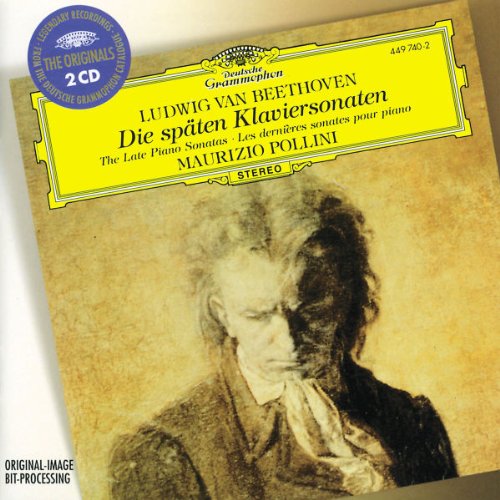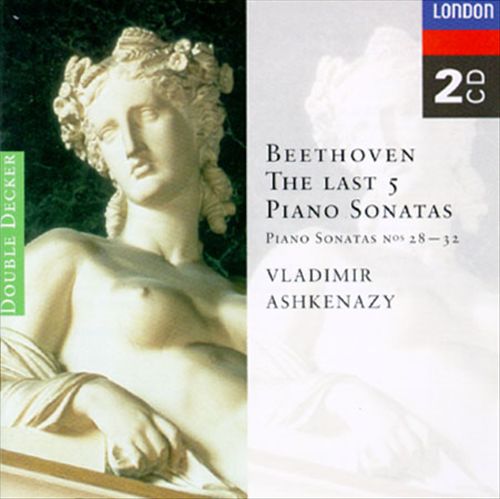Beethoven: Late Piano Sonatas
View record and artist detailsRecord and Artist Details
Composer or Director: Ludwig van Beethoven
Genre:
Instrumental
Label: DG
Magazine Review Date: 12/1986
Media Format: CD or Download
Media Runtime: 125
Mastering:
ADD
Catalogue Number: 419 199-2GH2

Tracks:
| Composition | Artist Credit |
|---|---|
| Sonata for Piano No. 28 |
Ludwig van Beethoven, Composer
Ludwig van Beethoven, Composer Maurizio Pollini, Piano |
| Sonata for Piano No. 29, 'Hammerklavier' |
Ludwig van Beethoven, Composer
Ludwig van Beethoven, Composer Maurizio Pollini, Piano |
| Sonata for Piano No. 30 |
Ludwig van Beethoven, Composer
Ludwig van Beethoven, Composer Maurizio Pollini, Piano |
| Sonata for Piano No. 31 |
Ludwig van Beethoven, Composer
Ludwig van Beethoven, Composer Maurizio Pollini, Piano |
| Sonata for Piano No. 32 |
Ludwig van Beethoven, Composer
Ludwig van Beethoven, Composer Maurizio Pollini, Piano |
Composer or Director: Ludwig van Beethoven
Genre:
Instrumental
Label: Decca
Magazine Review Date: 12/1986
Media Format: CD or Download
Media Runtime: 0
Mastering:
ADD
Catalogue Number: 417 150-2DH2

Tracks:
| Composition | Artist Credit |
|---|---|
| Sonata for Piano No. 28 |
Ludwig van Beethoven, Composer
Ludwig van Beethoven, Composer Vladimir Ashkenazy, Piano |
| Sonata for Piano No. 29, 'Hammerklavier' |
Ludwig van Beethoven, Composer
Ludwig van Beethoven, Composer Vladimir Ashkenazy, Piano |
| Sonata for Piano No. 30 |
Ludwig van Beethoven, Composer
Ludwig van Beethoven, Composer Vladimir Ashkenazy, Piano |
| Sonata for Piano No. 31 |
Ludwig van Beethoven, Composer
Ludwig van Beethoven, Composer Vladimir Ashkenazy, Piano |
| Sonata for Piano No. 32 |
Ludwig van Beethoven, Composer
Ludwig van Beethoven, Composer Vladimir Ashkenazy, Piano |
Author: Edward Greenfield
Comparisons are not quite what I expected. Remembering the consistent praise which has been heaped on the Pollini set, I have been alarmed just how consistently and to what a degree I have preferred the Ashkenazy versions. I always did feel that the Pollini set had a chill, steely side to it, and the overall timings of the rival set give one obvious reason why: his speeds are generally faster, and though in the first movement of the Hammerklavier the astonishing technical assurance has you on the edge of your seat with excitement, there are other times when his performances seem relentless, particularly when the CD transfer (not remixed) underlines the aggressive side of the recording. I was at first inclined to blame the recording for the absence of any dynamic marking below mezzo forte in many movements, but Pollini—in the slow movement of the Hammerklavier for example—shows that he can, when he wants, play on a whisper of half-tone. Too often I am also worried by his reluctance to play with a real legato, often jabbing at individual notes within a phrase.
All this is the obverse of what I find very sympathetic in the Ashkenazy readings. I had always counted them reliable rather than inspired, not so individual as, say, Kempff, Barenboim or Brendel, but hearing this set as a group reinforces both what dedication, thoughtfulness and natural warmth there are in the playing and what freshness and strength. As ever Ashkenazy's favourite expressive trick is a personal agogic hesitation on salient notes, but only rarely does that sound contrived. Otherwise his preference for relatively steady speeds makes Pollini sound fitful and even nervy by comparison with fast speeds too often lurching ahead or being held back. And Ashkenazy in a movement like the Scherzo of the Hammerklavier at his less hectic speeds finds an element of fantasy missing with Pollini. Equally, in the elusive lyrical first movement of Op. 101 (a personal favourite with me) Ashkenazy's use of rubato is far more natural, less jerky, and at a more relaxed Allegretto the music flows more easily with a far wider gradation of dynamic and tone-colour.
That is partly a question of recording quality, and the CD transfers of the analogue originals of Op. 101, and the last three sonatas, readily match the fine digital recording of the Hammerklavier, with tape hiss less often audible than with the Pollini/DG. Ashkenazy is, however plagued at times by a twangy note or two on his paino. The DG booklet—larger than the Decca—contains separate notes (unattributed) on each of the five sonatas, where Decca have a perceptive essay on all five together by Misha Donat. It is an irritating omission that DG do not provide timings of individual movements, though of course you can work them out from the digital display if your machine is so equipped.'
Explore the world’s largest classical music catalogue on Apple Music Classical.
Included with an Apple Music subscription. Download now.

Gramophone Digital Club
- Digital Edition
- Digital Archive
- Reviews Database
- Events & Offers
From £9.20 / month
Subscribe
Gramophone Club
- Print Edition
- Digital Edition
- Digital Archive
- Reviews Database
- Events & Offers
From £11.45 / month
Subscribe
If you are a library, university or other organisation that would be interested in an institutional subscription to Gramophone please click here for further information.






